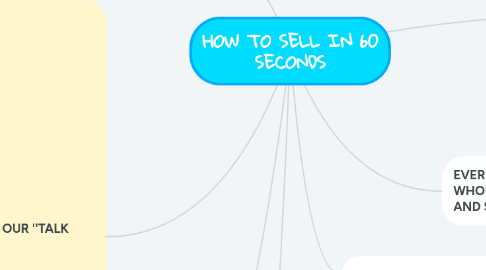
1. STRICT LIMITS ON OUR ''TALK TIME''
1.1. ASK OPENENDED ''PROMPTING'' QUESTIONS
1.1.1. •Cannot be answered with a simple yes or no. •Do not lead, control or try to manipulate the other person. •Enable dialoging. •Begin with the words "when," "what," "how," "why" or "where." •Require thought to be answered. •Encourage the other person to reveal feelings. •Build rapport.
1.2. CLOSED-ENDED QUESTIONS
1.2.1. Is in a situation where you need to validated or confirm what you think is going on in your prospect's world
1.2.1.1. •Are useful to give feedback during a dialog. •Can be used to obtain specific information and/or confirm facts.
1.3. CLARIFYING QUESTIONS
1.3.1. BEGIN WITH THE WORDS
1.3.1.1. SO
1.3.1.2. If I understand you correctly
1.3.1.3. you are saying that....
1.3.2. WARNING!
1.3.2.1. You should always preface your clarifying question with a statement such as this and then creatively paraphrase what you think your contact's main point is.
1.3.3. •Secure the other person's approval and prove to a greater degree that you've got a good understanding of what he or she said. •Express in your own words what you just heard. •Clear up differences in the definition of words and phrases being used. •Clarify the meaning of "global" words (like "always" and "never").
2. DEVELOPMENTAL QUESTIONS
2.1. •Encourage the other person to elaborate on what he or she just said. •Begin to make it possible for the other person to show his or her true feelings about the topic at hand. •Obtain further definition of what's under discussion. Optio
3. OPINION QUESTIONS
3.1. Ask a direct question in a nonconfrontational way.
3.2. Get the other person to speak frankly and openly.
3.3. Show esteem and respect for the other person.
3.4. Help to extend and prolong dialogues.
4. FIRST SEEK TO UNDERSTAND WHAT'S GOING ON THE OTHER PERSON'S WORLD
5. ASK INTELLIGENT QUESTIONS
6. EVERY ONE OF US SHOULD ASK A WHOLE LOT MORE QUESTIONS AND SPEAK A WHOLE LOT LESS
7. DIRECTIONAL QUESTIONS
7.1. •Move the dialog from one logical topic to another. •Invite the other person to participate in an informational exchange. •Can be used to replace a closed-ended question you were tempted to ask.
7.1.1. Important: Don't fall into the trap of using directional questions to control or manipulate the prospect in any way. This will destroy any business rapport you've built and reduce your chances of getting a second appointment.

